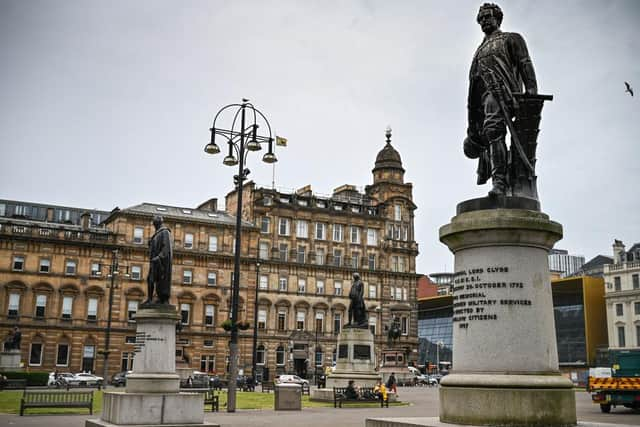Glasgow statues: Report highlights links between slavery and statues
and live on Freeview channel 276
‘Glasgow, slavery and Atlantic commerce: An audit of historic connections and modern legacies’, written by Dr Stephen Mullen, looks at Glasgow’s links with Atlantic commerce and slavery.
The report focuses on various issues - from buildings and individuals, to street names and statues.
Advertisement
Hide AdAdvertisement
Hide AdEight monuments are included in the report, six of which can be found in George Square.
Which statues have connections to slavery?
Colin Campbell, William Gladstone, John Moore, David Livingstone, James Oswald, Robert Peel Jnr, James Watt and King William are all mentioned in the report.


Colin Campbell (George Square)
As an army office, he was stationed in the British West Indies and was transferred to Demerara-Essequibo (now British Guiana) in 1821, where he remained for five years. The Demerara Rebellion broke out in 1823, involving over 10,000 enslaved people.
The report says: “Campbell was certainly part of the colonial infrastructure that reinstated imperial order (although his actual military role remains unclear).”
Advertisement
Hide AdAdvertisement
Hide AdHe also sat on the court martial when Rev John Smith was put on trial, accused of inciting the rebellion. Rev Smith would die before his execution could be carried out.
William Gladstone (George Square)
The four-time Prime Minister is one of British history’s political behemoths. He was awarded the Freedom of the City of Glasgow and served as rector at the University of Glasgow.
However, his dad, John, was a major owner of enslaved people in the British West Indies and was given £112,000 when slavery was abolished for the loss of his enslaved ‘property’.
William was gifted hundreds of thousands of pounds by his father, and he himself helped protect the financial interests and reputations of those involved in slavery.
Advertisement
Hide AdAdvertisement
Hide AdJohn Moore (George Square)
Glasgow-born Sir John Moore was a British Army general who helped consolidate British control over St Lucia, even serving as governor.
Following the French Revolution a number of slaves were inspired to declare themselves free. Moore wrote that many had been subdued and “above three hundred have been killed”.
David Livingstone (Cathedral Square)
The famous explorer spent some of his early years working at the Blantyre cotton mill. It is likely the cotton for the mill came from the West Indies. He returned to the mill later in life.
While he described slavery as the “greatest meanness ever perpetrated”, he did come to the defence of cotton mill owners.
Advertisement
Hide AdAdvertisement
Hide AdThe report argues that his cotton mill earnings funded his rise.
James Oswald (George Square)
James Oswald of Shieldhall was the son of a tobacco lord. Not only did he inherit his estate, he also inherited another slavery fortune when his cousin died. He also invested in cotton spinning mill.
He later funded moves towards the abolition of plantation slavery in 1834 - although he also helped the Glasgow West India Association secure a final pay-off. In 1836, he also supported the petition to end the apprenticeship scheme (another system of unpaid labour).
Robert Peel Jnr (George Square)
Robert Peel Jnr, an MP and Home Secretary, pushed the pro-slavery position in Parliament. He opposed the abolition of plantation slavery in 1834 and was regarded as a ‘hero’ by those with interests in West India.
Advertisement
Hide AdAdvertisement
Hide AdJames Watt (various)
The inventor was the son of a transatlantic merchant operating from Greenock, whose commerce involved produce grown by enslaved people.
As well as helping his father’s business, James also was directly involved in the trafficking of a likely enslaved child to a gentry family.
The George Square statue followed a campaign led by then Lord Provost of Glasgow, Mungo Nutter Campbell, a West India merchant and enslaver.
King William (near Cathedral Square)
King William III owned shares in the Royal African Company, which held monopoly over all English slave trading from the west coast of Africa to Americas from 1672 onwards.
Advertisement
Hide AdAdvertisement
Hide AdHe was gifted shares when he became the king, however, the report states he seemed to use the RAC as a maritime power against the French instead of a profit-making exercise.
How was the research conducted?
For his work on Glasgow’s statues, Dr Mullen used the ‘comprehensive’ Public Sculpture of Glasgow book as a guide, which provides some biographic information.
Public sources were used to find information on statues erected in the last 20 years, after the book was published.
He then used archival research to find connections to chattel slavery.
Comment Guidelines
National World encourages reader discussion on our stories. User feedback, insights and back-and-forth exchanges add a rich layer of context to reporting. Please review our Community Guidelines before commenting.
